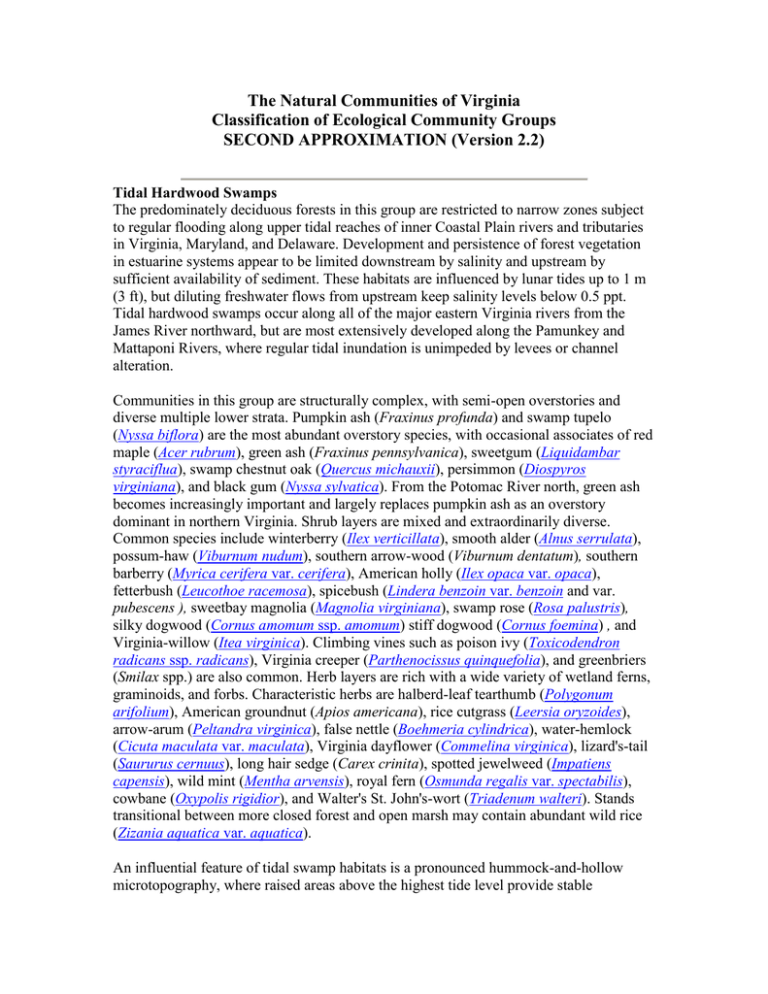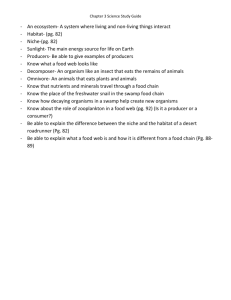The Natural Communities of Virginia Classification of Ecological Community Groups
advertisement

The Natural Communities of Virginia Classification of Ecological Community Groups SECOND APPROXIMATION (Version 2.2) Tidal Hardwood Swamps The predominately deciduous forests in this group are restricted to narrow zones subject to regular flooding along upper tidal reaches of inner Coastal Plain rivers and tributaries in Virginia, Maryland, and Delaware. Development and persistence of forest vegetation in estuarine systems appear to be limited downstream by salinity and upstream by sufficient availability of sediment. These habitats are influenced by lunar tides up to 1 m (3 ft), but diluting freshwater flows from upstream keep salinity levels below 0.5 ppt. Tidal hardwood swamps occur along all of the major eastern Virginia rivers from the James River northward, but are most extensively developed along the Pamunkey and Mattaponi Rivers, where regular tidal inundation is unimpeded by levees or channel alteration. Communities in this group are structurally complex, with semi-open overstories and diverse multiple lower strata. Pumpkin ash (Fraxinus profunda) and swamp tupelo (Nyssa biflora) are the most abundant overstory species, with occasional associates of red maple (Acer rubrum), green ash (Fraxinus pennsylvanica), sweetgum (Liquidambar styraciflua), swamp chestnut oak (Quercus michauxii), persimmon (Diospyros virginiana), and black gum (Nyssa sylvatica). From the Potomac River north, green ash becomes increasingly important and largely replaces pumpkin ash as an overstory dominant in northern Virginia. Shrub layers are mixed and extraordinarily diverse. Common species include winterberry (Ilex verticillata), smooth alder (Alnus serrulata), possum-haw (Viburnum nudum), southern arrow-wood (Viburnum dentatum), southern barberry (Myrica cerifera var. cerifera), American holly (Ilex opaca var. opaca), fetterbush (Leucothoe racemosa), spicebush (Lindera benzoin var. benzoin and var. pubescens ), sweetbay magnolia (Magnolia virginiana), swamp rose (Rosa palustris), silky dogwood (Cornus amomum ssp. amomum) stiff dogwood (Cornus foemina) , and Virginia-willow (Itea virginica). Climbing vines such as poison ivy (Toxicodendron radicans ssp. radicans), Virginia creeper (Parthenocissus quinquefolia), and greenbriers (Smilax spp.) are also common. Herb layers are rich with a wide variety of wetland ferns, graminoids, and forbs. Characteristic herbs are halberd-leaf tearthumb (Polygonum arifolium), American groundnut (Apios americana), rice cutgrass (Leersia oryzoides), arrow-arum (Peltandra virginica), false nettle (Boehmeria cylindrica), water-hemlock (Cicuta maculata var. maculata), Virginia dayflower (Commelina virginica), lizard's-tail (Saururus cernuus), long hair sedge (Carex crinita), spotted jewelweed (Impatiens capensis), wild mint (Mentha arvensis), royal fern (Osmunda regalis var. spectabilis), cowbane (Oxypolis rigidior), and Walter's St. John's-wort (Triadenum walteri). Stands transitional between more closed forest and open marsh may contain abundant wild rice (Zizania aquatica var. aquatica). An influential feature of tidal swamp habitats is a pronounced hummock-and-hollow microtopography, where raised areas above the highest tide level provide stable substrates for the establishment of trees and microhabitats for more mesophytic forest herbs. These swamp forests also support cryptic animal species such as the prothonatory warbler (Protonataria citrea) and the two-toed amphiuma (Amphiuma means), as well as more noticeable species including the bald eagle (Haliaeeatus leucocephalus). Tidal hardwood swamps are considered globally uncommon to rare and are threatened by the invasive introduced forb, marsh dewflower (Murdannia keisak), and by chronic sea-level rise. Crown dieback and tree mortality are visible and nearly ubiquitous phenomena in these communities and are generally attributed to sea-level rise and an upstream shift in the salinity gradient in estuarine rivers. References: Ahnert (1960), Coulling (2002), Doumlele et al . (1985), McCoy and Fleming (2000), Rheinhardt (1992). Click on the images below to open a larger image in a separate window. Arrow-arum (Peltandra virginica), cardinalflower (Lobelia cardinalis), and spotted jewelweed (Impatiens capensis) in the herb layer of a tidal hardwood swamp along Bailey Creek, near its confluence with the James River, Henrico County. Photo: Irvine Wilson / © DCR Natural Heritage. Wood reed grass (Cinna arundinacea) and wild mint (Mentha arvensis) in the herb layer of a tidal hardwood swamp along Accokeek Creek, near its confluence with Potomac Creek, Stafford County. Photo: Irvine Wilson / © DCR Natural Heritage. REPRESENTATIVE COMMUNITY TYPES: The Tidal Hardwood Swamp type is well supported by data from the Pamunkey and Mattaponi Rivers. Although the Mattaponi stands appear comparatively depauperate, this phenomenon is likely the result of more rapid data collection from smaller plots later in the growing season. The occurrence and extent of this community on other river systems in the state is uncertain. In particular the James and Rappahannock Rivers support extensive swamp forests which may or may not be subject to regular, diurnal tides and which have yet to be inventoried. In addition, although the USNVC association CEGL006287 represents tidal hardwood swamp vegetation from Delaware to Virginia, compositional variation may warrant the recognition of a separate tidal hardwood swamp type in northern Virginia. It is uncertain whether the Tidal Marsh Woodland represents natural, recurring vegetation or an artifact of disturbance in ecotonal habitats resulting from sea-level rise. Additional examples should be sought. Click on any highlighted CEGL code below to view the global USNVC description provided by NatureServe Explorer. (Fraxinus profunda, Fraxinus pennsylvanica, Nyssa biflora) / Agalinis purpurea – Rhynchospora macrostachya var. colpophila Wooded Herbaceous Vegetation (PROVISIONAL) Mid-Atlantic Tidal Marsh Woodland USNVC: no equivalent Global/State Ranks: GNR/SNR Endemic Fraxinus profunda – Nyssa biflora / Ilex verticillata – Alnus serrulata / Polygonum arifolium Tidal Forest Mid-Atlantic Tidal Hardwood Swamp USNVC: = CEGL006287 Global/State Ranks: G3/S3



